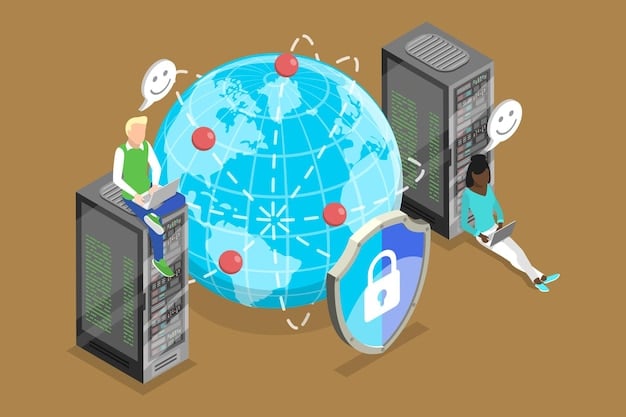Crypto Security in the Cloud: Best Practices for Protecting Your Data and Assets

Crypto security in the cloud involves implementing robust strategies such as encryption, access controls, and threat detection to safeguard digital assets and data from cyber threats, ensuring the integrity and confidentiality of blockchain-based systems hosted in cloud environments.
In today’s digital landscape, where cloud computing is increasingly prevalent, understanding and implementing robust crypto security in the cloud: best practices for protecting your data and assets is more critical than ever. As blockchain technology and cryptocurrencies gain traction, securing these assets within cloud environments becomes paramount. This article delves into the essential strategies and practices necessary to safeguard crypto assets in the cloud, ensuring both security and compliance.
Understanding the Landscape of Crypto Security in the Cloud
The shift towards cloud-based solutions has brought unparalleled flexibility and scalability, but it also introduces unique security challenges. For cryptocurrency businesses and enthusiasts, this means adapting security protocols to address cloud-specific vulnerabilities. Understanding these challenges is the first step in building a secure cloud infrastructure for crypto assets.
The cloud environment offers numerous benefits, including cost-effectiveness, accessibility, and automatic updates. However, these advantages come with risks such as data breaches, insider threats, and denial-of-service attacks. Securing crypto assets in the cloud requires a multi-faceted approach that includes both preventative and reactive measures.
Shared Responsibility Model
A key concept in cloud security is the shared responsibility model, which dictates that the cloud provider is responsible for the security “of” the cloud, while the customer is responsible for security “in” the cloud. This means that while the cloud provider ensures the security of the underlying infrastructure, you are responsible for securing your data, applications, and identities.
- Provider Security: Focuses on physical security, network security, and infrastructure management.
- Customer Security: Involves data encryption, access controls, compliance, and application security.
- Shared Responsibility: Requires a clear understanding of who is responsible for what, and collaboration between the provider and the customer.
Properly understanding and delineating the responsibilities ensures that there are no gaps in your security posture. This collaborative approach is essential for effective crypto security in the cloud: best practices for protecting your data and assets.

Recognizing and addressing these challenges is crucial for any organization storing sensitive cryptocurrency data in the cloud. By understanding the threat landscape, businesses can proactively secure their assets and maintain the trust of their users.
Implementing Robust Encryption Strategies
Encryption is the cornerstone of data protection, especially when it comes to securing crypto assets in the cloud. It transforms readable data into unreadable ciphertext, making it incomprehensible to unauthorized users. Employing strong encryption methods is vital for maintaining the confidentiality and integrity of crypto-related data.
Choosing the right encryption algorithm and managing encryption keys securely are critical components of an effective encryption strategy. Different algorithms offer varying levels of security and performance, and selecting the most appropriate one depends on your specific needs and risk tolerance.
Data-at-Rest Encryption
Data-at-rest encryption involves encrypting data when it is stored, whether on hard drives, databases, or cloud storage. This ensures that even if physical storage devices are compromised, the data remains unreadable without the encryption keys.
Data-in-Transit Encryption
Data-in-transit encryption protects data as it moves between systems or networks. This is typically achieved using protocols like TLS (Transport Layer Security) or VPNs (Virtual Private Networks), which establish secure channels for data transmission.
Implementing robust encryption strategies is a non-negotiable aspect of crypto security in the cloud: best practices for protecting your data and assets. Without proper encryption, your data remains vulnerable to a wide range of threats.
Securing Access with Multi-Factor Authentication and Identity Management
Access control is another critical component of crypto security in the cloud: best practices for protecting your data and assets. Ensuring that only authorized individuals have access to sensitive crypto assets requires implementing strong authentication mechanisms and robust identity management policies. Using multi-factor authentication (MFA) adds an extra layer of security, reducing the risk of unauthorized access.
Identity management involves creating, managing, and tracking digital identities within an organization. This includes user provisioning, deprovisioning, and role-based access control (RBAC), which assigns permissions based on job functions.
Implementing Multi-Factor Authentication
MFA requires users to provide two or more verification factors before granting access to a system or application. These factors can include something they know (password), something they have (security token or smartphone), or something they are (biometrics).
- Reduces Risk: Significantly lowers the probability of successful cyber-attacks.
- Compliance: Helps meet regulatory requirements and industry standards.
- User-Friendly: Modern MFA solutions offer seamless and non-intrusive user experiences.
Role-Based Access Control (RBAC)
RBAC assigns permissions based on the roles users hold within an organization. This ensures that individuals only have access to the resources they need to perform their job duties, minimizing the risk of insider threats and accidental data breaches.
By implementing robust access control measures such as MFA and RBAC, organizations can significantly enhance their security posture and protect their crypto assets from unauthorized access. These practices are essential for establishing a secure cloud environment.
Implementing Network Security Best Practices
Network security is essential to any **crypto security in the cloud: best practices for protecting your data and assets** strategy. Safeguarding the network infrastructure that supports cloud-based crypto operations is crucial for preventing unauthorized access and data breaches. Implementing robust network security practices can help organizations maintain the integrity and confidentiality of crypto assets.
A well-secured network incorporates a variety of defenses, including firewalls, intrusion detection systems, and network segmentation. These technologies work together to create a layered security approach, protecting against a wide range of cyber threats.
Firewall Management
Firewalls act as barriers between trusted and untrusted networks, controlling inbound and outbound traffic based on predefined rules. Properly configuring and managing firewalls is essential for preventing unauthorized access to sensitive systems and data.
Intrusion Detection and Prevention Systems (IDPS)
IDPS monitor network traffic for malicious activity and automatically respond to detected threats. These systems can identify and block a variety of attacks, including malware infections, denial-of-service attacks, and unauthorized access attempts.
By incorporating these network security best practices, organizations can significantly enhance the security of their cloud-based crypto operations and protect their valuable assets from cyber threats.

Regular Security Audits and Penetration Testing
Periodic security audits and penetration testing are crucial for validating the effectiveness of security measures and identifying potential vulnerabilities. These activities help organizations proactively address weaknesses before they can be exploited by attackers.
A security audit involves a comprehensive review of security policies, procedures, and controls. Penetration testing, on the other hand, simulates real-world attacks to identify vulnerabilities in systems and applications.
The Importance of Security Audits
Security audits provide an objective assessment of an organization’s security posture. They help identify gaps in security controls, ensure compliance with regulatory requirements, and provide recommendations for improvement.
Conducting Penetration Tests
Penetration tests involve ethical hackers attempting to exploit vulnerabilities in systems and applications. These tests can reveal weaknesses that might not be apparent through other means, helping organizations prioritize remediation efforts.
- Vulnerability Identification: Reveals hidden flaws in systems and applications.
- Risk Assessment: Helps quantify the potential impact of identified vulnerabilities.
- Compliance: Demonstrates due diligence to regulators and auditors.
Regular security audits and penetration testing are essential elements of this strategy. By validating the effectiveness of security measures and proactively addressing vulnerabilities, organizations can maintain a strong security posture and protect their crypto assets from evolving threats.
Incident Response and Disaster Recovery Planning
Even with the best security measures in place, incidents can still occur. Having a well-defined incident response and disaster recovery plan is crucial for minimizing the impact of security breaches and ensuring business continuity.
Incident response involves a coordinated set of actions to identify, contain, eradicate, and recover from security incidents. Disaster recovery focuses on restoring critical business functions after a disruptive event, such as a natural disaster or a major cyber-attack.
Creating an Incident Response Plan
An incident response plan should outline the roles and responsibilities of incident response team members, as well as the steps to be taken in the event of a security breach. This plan should be regularly tested and updated to ensure its effectiveness.
Developing a Disaster Recovery Plan
A disaster recovery plan should identify critical business functions and the resources required to restore them. This plan should include backup and recovery procedures, as well as alternative operating locations.
By developing and maintaining robust incident response and disaster recovery plans, organizations can minimize the impact of security incidents and ensure the continuity of their crypto operations.
| Key Aspect | Brief Description |
|---|---|
| 🔑 Encryption Methods | Utilize data-at-rest and data-in-transit encryption for enhanced security. |
| 🛡️ Access Controls | Implement MFA and RBAC to secure access to crypto assets. |
| 🔍 Security Audits | Perform regular audits and penetration tests to identify vulnerabilities. |
| 🚨 Incident Response | Have a plan to address security breaches and ensure business continuity. |
Frequently Asked Questions (FAQ)
▼
The shared responsibility model divides security tasks between the cloud provider and the customer. The provider secures the infrastructure, while the customer secures data, applications, and identities.
▼
Encryption protects data by rendering it unreadable without the correct key. It ensures that even if unauthorized access occurs, the data remains confidential and secure.
▼
MFA requires users to provide multiple verification factors, making it more difficult for attackers to gain unauthorized access, even if they have a password.
▼
Penetration testing simulates real-world attacks to identify vulnerabilities in systems and applications, helping organizations address weaknesses before they can be exploited.
▼
An incident response plan provides a structured approach to managing security incidents, minimizing their impact and ensuring a swift and effective recovery to maintain business continuity.
Conclusion
Securing crypto assets in the cloud requires a comprehensive and layered approach that incorporates robust encryption, strong access controls, proactive monitoring, and incident response planning. By implementing these best practices, organizations can significantly enhance their security posture and protect their valuable crypto assets from evolving cyber threats.





